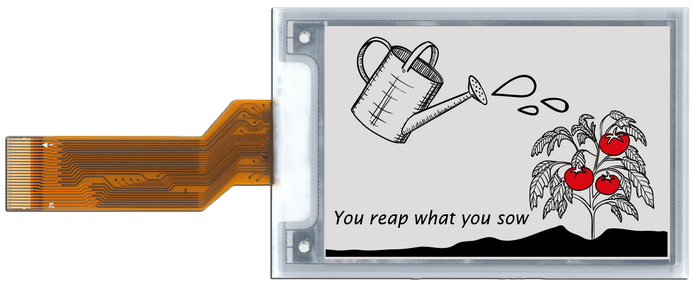Adding a low power display to a Maker project
7 Nov 2017
Have you ever thought how great it would be if you had a sign on your front door that said ‘Hello’ just as you approached to put your key in? Or you could see if you should take an umbrella to work with you, just by looking at your coffee table? Or you knew if you were running low on sugar just by glancing at the closed cupboard door? If the answer to any of these questions is ‘Yes’ then you’re probably already a Maker. If it’s ‘Yes please!’ then you’re a Maker in the making and you might just be looking for e-paper displays.
Accessing technology for your project
The number of single-board computer modules available to Makers is on the increase. Platforms like the Raspberry Pi family give everyone access to technology that, not so long ago, would only have been available to large companies making electronic products in high volumes. Today, the same amount of processing power you might find in an average laptop computer is available in an easy to use and extensible format, for a fraction of the price. This level of accessibility is fueling the Maker Movement, which in conjunction with other technologies like Additive Manufacturing (3D Printing) is enabling enthusiasts to create exiting new products. Crowd-funding websites are playing their part, too. Anyone with a concept can now quickly turn that idea into reality, share it with the world and possibly get complete strangers to back their project. The speed with which ideas can be realized and turned into viable product is truly inspiring.
The rise of the IoT
But what’s more inspiring is the diversity of those ideas. Adding electronics seems to give anything a new lease of life; turning the mundane into the amazing. One favorite with the Maker Community seems to be automating plant watering (handy for those long weekends spent at the bench!). Who knew that, when the integrated circuit was first conceived around 60 years ago, one day technology would be so democratized that you could build your own computer for little more than the cost of a posh coffee. The momentum behind Making is so high that the thirst for new technologies can never be quenched. Right now, the Internet of Things (IoT) is the driving force behind Making, by adding connectivity such as Wi-Fi, Ethernet, Bluetooth and ZigBee to projects. The next step will be improving the overall user experience.
Which display should you choose?
When it comes to the user experience it is easy to appreciate the impact a display makes. Headless systems (those without a display), like smart sensors for example, will be prolific in the IoT but to create a real ‘connection’ with technology takes a richer user interface and that normally means some kind of display. Of all the display technologies currently in use, LCDs (Liquid Crystal Displays) are the most common. They are relatively cheap and available in many shapes and sizes, but they have one feature that is hard to optimize, the power they consume. This can be a problem for applications that are power-constrained, such as battery powered or harvested-energy devices. For the kind of applications a Maker may be interested in, an LCD may be simply too energy hungry to be viable. But this doesn’t mean they have to give up on the idea of adding a user display to their application.

Benefits of e-paper compared with LCDs
Unlike an LCD, e-paper displays don’t consume power all the time they’re being used. Their underlying technology is based on electronic ink (E Ink) which is stable in two states; for monochrome displays this means a pixel can remain either white or black when power is removed. In fact, text or images remain persistent on the screen even when power is completely removed. This contrasts vividly with an LCD, which must constantly apply energy to provide a persistent image. This puts the power requirements of an LCD orders of magnitude higher than an e-paper display; in the case of displays with a backlight this power consumption is even higher.
EPDs and NFC
Because e-paper only uses energy when the text or image on the screen needs to change, e-paper displays can be used in devices where power is limited. This includes battery powered devices, of course, but it extends to include devices that use energy that has been harvested from the environment, or ‘free’ energy. It is even feasible to create a device that uses the energy provided by a Near Field Communication (NFC) reader to power the entire system, including the display. The applications for this kind of technology are virtually unlimited.
Get started with an e-paper kit!
Makers are, by nature, resourceful and inventive. They love nothing more than to push the boundaries of what’s possible using the technology at hand. Now that Pervasive Displays is providing kits that target single-board computer modules like the Raspberry Pi, we can expect to see a new era of intelligent devices. Let the Making commence!
Blogger: Hardy Kuo, Field Applications Engineer, Pervasive Displays
Category: Blog
Back to News